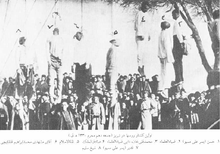Russian occupation of Tabriz

Russian Invasion of Tabriz, 1911 (Persian: (اشغال تبریز بدست قوای روس (۱۲۹۰ خورشیدی) refers to the attack and invasion of the city of Tabriz in the north western part of Iran in December 1911 by Imperial Russia, which lasted up to the course of World War I. This occupation was in retaliation to the Iranian Parliament's refusal to accept the Russian ultimatum. The Russian Ultimatum had three major requests from the Iranian government, amongst which the most important was to depose the newly employed American lawyer, Morgan Shuster. Shuster was assigned by the Parliament of Iran to organise the country's financial affairs.
Upon the Iranian parliament's refusal to depose Shuster, the Russian Imperial Army started its campaign in the North Western part of Iran. Its aim was to occupy three major cities: Tabriz, Anzali, and Rasht. The most fierce occupation occurred in Tabriz. The war in Tabriz lasted about three days till the resistance of the city its residents broke. Then Russians shelled Tabriz with artillery and started to invade the city.
Upon gaining full control of the city, the Russians started mass execution of famous constitutional revolutionaries of Tabriz as well as ordinary residents of Tabriz. The total number of executions is about 1,200 Tabriz residents. Russians also destroyed part of Arg of Tabriz by shelling it and then putting it on fire.[1]
-
Russian flag over Arg of Tabriz.
-
Spread of fire in Arg because of carelessness of Russian troops.
See also
References
- ^ Hasan Javadi; Edward Granville Browne (2008). Letters from Tabriz: The Russian Suppression of the Iranian Constitutional Movement. Mage Publishers. ISBN 978-1-933823-25-6.


